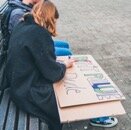We've certainly covered a lot of ground over the past weeks, beginning with the FUTURES™ holiday posts that showcased ways to align holiday spending strategies to the principles of financial literacy. More recent posts focused on goal setting and the benefits of service to all. As we wind up this wave of 12 blog posts, let’s take a deep dive into the program to share the incredible value it offers to you, your children, and your community.
Check out Blog 12’s big-picture view of FUTURES’ four program strands: Personal Finance, Economics, Investing, and Entrepreneurship. To inspire you to give the program a try, we included a few worksheets that you can put right to use with your class, family, club, or organization. We’ve dubbed these deep-dive Power Boosts! Each Power Boost provides a glimpse of the program’s approach, the strand’s focus, worksheets, and instruction—that you can immediately use to boost your curriculum—and your own financial literacy strengths!
Power Up for the Future
The FUTURES program simplifies and deconstructs complicated, intricate Financial Literacy concepts to make them relevant and easier to understand for everyone. With the full FUTURES program at your fingertips, you can help your kids better understand the complicated world of finance AND develop their own personal stake in it. Created by teachers for teachers, this proven educational program is FREE and readily available to districts, schools, teachers, coaches, counselors, and families, too!
Real-time, real-world connections help drive everyone’s interest, especially kids’, and create effective links between academic content and the business world. This unique multi-disciplinary approach elevates learning, allowing educators, school districts, families, and community centers to help prepare tomorrow’s leaders—today—so they can compete in and become strong leaders of our ever-changing global marketplace—in their future.
Power Boost 1: Personal Finance IS Personal
Personal Finance is just that – personal —and as a result, it’s valuable for everyone: kids, teachers, leaders, and families alike. With the help of the FUTURES™ program, kids can begin to more clearly define and understand a budget, the various categories within a budget, learn to create a budget, make budget adjustments, and apply this knowledge in memorable real-world settings. As kids create their own budgets after tracking expenses over time, learning the differences between a job and a career, a need and a want, and many other financial literacy nuances, budgeting becomes familiar and more infused into their learning strategies. From learning how to budget, kids discover the power of giving. Check out this Philanthropy Flow Chart. It’s a great easy-to-include tool to fuel a conversation about how philanthropy works so you can work philanthropy into your daily world.
Like all strands of FUTURES™, the Personal Finance strand is designed to help you “meet your kids where they are.” Each of the program’s 29 sections across all four strands is organized around a Focus Question. For example, the Budget and Goal Setting section asks kids to consider the following: “When, how, and why is it beneficial to manage your money?” It's this kind of personalization that makes the learning process more relevant. It engages and involves the kids, inspiring them to really think about what they might do in a range of financial situations. These are just some of the Personal Finance strategies that help to makes FUTURES such a successful Financial Literacy program.
Power Boost 2: Easy-to-Grasp Economics, Anyone?
Let’s take a look at the second of the four FUTURES: Financially Literate Kids for a Financially Literate Society™ strands—Economics. What better way to help kids learn to better handle and manage money than by understanding how the system behind it works? This program’s in-depth Economics strand covers a wealth of topics:
Consumers and Producers
Currency and Federal Reserve
Goods and Services
Scarcity
Opportunity Cost
Federal Government Taxes and Role of Government
Productive Resources
Specialization and Division of Labor
In this part of the program, a variety of section resources introduce economics concepts using fun activities and familiar real-world scenarios including a city council budget, the fairness of a trade, and how advancements in musical technology impact consumers. Through leveled resources, students will learn the roles of consumers and producers, look at how money is used as a medium of exchange, and examine the trading process from various angles as well as gain an understanding of how goods and services are produced, consumed and exchanged.
Scenarios for All Occasions
This Scenarios Chart can be universally used to sift through a host of different scenarios in any exploration—even those that go far beyond Economics. This makes a great activity for early finishers, too.
FUTURES guided, easy-to-access lesson plan approach that you can begin to coach your kids to expand their ideas about Personal Finance and Economics. This program helps to explain the larger role of Economics to everyone, while building upon the base understanding from the Personal Finance strand, enlarging the scope of their financial literacy world, carefully explaining how businesses work within their own world and in the greater world view. Clarity about concepts like the flow of money and target markets are vital. These are defined in easy-to-understand language and through engaging worksheets, helping kids can begin to formulate a better understanding of just how much the economy impacts both their own lives and the world around them.
Power Boost 3: Stock Up on Investing Ideas
To inspire kids to explore companies and stocks, start by asking kids what real companies they like—and why. Ask them what they think it would be like to invest in these companies. Help by choosing your favorite company too and going through this activity together. Ask the kids to brainstorm some of their favorite companies and make a list of five favorite companies. Invite them to choose just one for this exercise. By encouraging kids to invest in companies with products they already support and like, they’ll learn a very valuable investing lesson: investors need to understand the company, its end users, the customer base, the market segments, and the company’s philosophies and priorities in order to be a savvy investor.
It's Your Decision
It's important to stress that each kid can make a personal choice about their company—there’s no right or wrong choice. Give kids ample time to think about their choices, favorites, and ultimate decision to help them form their Investment Philosophy, a set of guiding principles that inform and shape their investment decision-making process. Some classic investing philosophies include:
Value Philosophy
Fundamental Philosophy
Growth Philosophy
Socially Responsible Philosophy
Technical Philosophy
Contrarian Philosophy
How to Read Stocks
Divide students into pairs and distribute copies of the Stock Vocabulary Worksheet to each pair of students. After you’ve reviewed terms and definitions, invite kids to research stock quotes online, working with partners to make predictions on what each term means. Students can record their predicted definitions in the second column of the worksheet. Project the How to Read Stock Tables projectable and guide students in selecting a stock from the Dow or NASDAQ and complete the My Stock Worksheet according to the stock’s quote in the online report.
Students can share their understanding of the terms through their selected stock. Definitions can be revised directly on their copies of the Stock Vocabulary Worksheet as they discuss their findings. Finally, create a large interactive poster of a stock quote table so student groups can follow and record their stock’s quote report using sticky notes to update the display daily. Make sure students also write the date and time to each sticky note update.
Power Boost 4: Entrepreneurship
The program’s detailed Entrepreneurship strand covers more than just Entrepreneurship; it covers a wealth of powerful future-focused leadership concepts for kids. From business startup and financing, flow of money, public and private corporations, target markets and the always important social responsibility, kids are able to experience and visualize themselves as entrepreneurial leaders. After all, tomorrow isn’t that far away!
With the help of fun FUTURES worksheets and games like the ones that follow, kids can unlock a richer grasp of what it means to be an entrepreneur. Kids will also explore the various parts of building and running a successful business, learn how a franchise works, discover the difference between investing in a startup business versus a franchise, and investing in a business and running that same business every single day (and night!). Kids consider various factors for starting a business and the importance of goal setting at the beginning stages of the business—and every single day thereafter.
The Entrepreneurship strand helps kids explore how they might want to run their own businesses one day—soon. Many of the kid s you know today could soon be ready to start their very own businesses, becoming the entrepreneurs of tomorrow—with this strong jumpstart from FUTURES—and you! For more information about how to incorporate these worksheets into your lesson plans or family adventures in finance, clik here to download the entire FUTURES: Financially Literate Kids for a Financially Literate Society™ today—with Ariel Education Initiative’s compliments!
These Power Boosts provide just a glimpse of how the FUTURES program simplifies and deconstructs complicated, intricate Financial Literacy concepts to make them relevant and easier to understand for everyone.
Onward Toward Our FUTURES
We hope you enjoyed and benefited from this wave of 12 Financial Literacy posts to welcome 2020 in a financially literate and responsible way. For more information about FUTURES: Financially Literate Kids for a Financially Literate Society™, this amazing (and FREE!) financial literacy program for students in kindergarten through eighth grade, or to download sections from the program, please click below. Should you find yourself looking to connect financial literacy concepts to everything from curriculum themes to family life lessons, you’ll continue to be able to download and use this program with our compliments—any time, any place—to help your kids grow and flourish into Financially Literate Kids who become part of a Financially Literate Society.
































